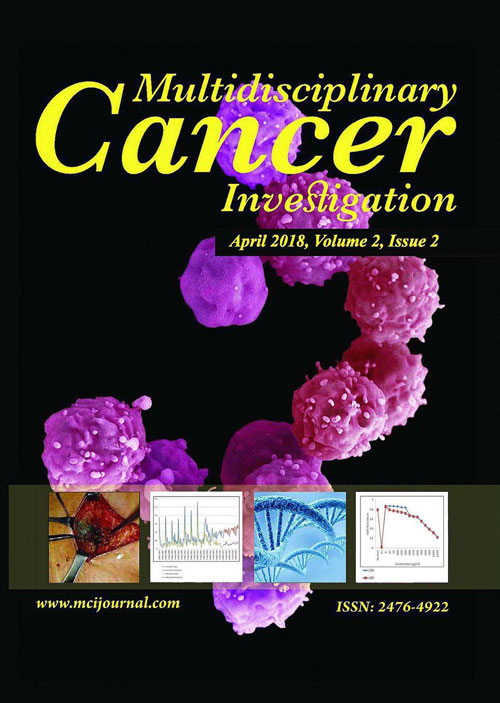فهرست مطالب

Multidisciplinary Cancer Investigation
Volume:2 Issue: 2, Apr 2018
- تاریخ انتشار: 1397/05/08
- تعداد عناوین: 4
-
-
Pages 1-7IntroductionEfforts are made to identify the new potential components such as anticancer drugs. Medicinal plants belonging to Euphorbia genus are widely studied with promising effects. The current study aimed at investigating the effect of ethanolic extract of the root of E. tehranica, grown in Iran, on Caco-2 human colorectal cancer cell-line.MethodsThe Caco-2 cells were treated with different concentrations of the root of E. tehranica ethanolic extract (25 to 1200 μg/mL) at 24 and 48 hours. Cell growth was evaluated with MTT assay. Anticancer activity of the ethanolic extract was assessed by evaluating the cell viability. Cell viability was determined at the wavelength of 570 nm by MTT method. The IC50 (half maximal inhibitory concentration) was determined graphically. One-way ANOVA followed by Tukeys post-test; and P valuesResultsThe findings showed the significant cytotoxic effect of the root of E. tehranica ethanolic extract against Caco-2 cell-lines (P ≤0.05). Therefore, the viability of Caco-2 cells reduced with the dose and time-dependent manner, when compared with that of the control group. Also, the differences between the IC50 in 24 and 48 hours were 850 and 855 μg/mL, respectively.ConclusionsIt was the first study on the effect of the root of E. tehranica ethanolic extract on human colon cancer cell-lines. The results showed that this extract had the capacity to inhibit proliferation of tumor cells. Therefore, it seems to be a good candidate to defend against cancer cells.Keywords: Euphorbia Tehranica, Ethanolic Extrac, Caco, 2, Anticancer Activity
-
Pages 8-13IntroductionLack of a proper method for early detection and diagnostic errors in medicine are some fundamental problems in treating cancer. Data analysis techniques may significantly help early diagnosis. The current study aimed at applying and evaluating neural networks and decision tree algorithm on breast cancer patients data for early cancer prediction.MethodsIn the current study, data from Breast Cancer Research Cancer (BCRC), ACECR (the Academic Center for Education, Culture and Research) were used consisting of data from 4004 patients with breast cancer risk factors. Of all records, 1642 (41%) were related to malignant changes and breast cancer and 2362 (59%) were related to benign tumors. Data were analyzed by neural networks perceptrons and decision tree algorithm and divided into two parts for training (70%) and testing (30%) using Rapid Miner 5.2.ResultsFor decision tree, accuracy of 81.62%, specificity of 79.80%, sensitivity of 89.49%, and for neural network, accuracy of 81.62%, specificity of 89.99%, and sensitivity of 90.80% were reported. Results showed acceptable capabilities to analyze breast cancer data for both algorithms.ConclusionsAlthough both models provided good results, neural network showed better diagnosis for positive cases. Database type and analysis method influenced the results. On the other hand, information about more powerful risk factors of breast cancer can provide models with high coverage.Keywords: Decision Tree, C5.5, Neural Network, Breast Cancer, Data Mining
-
Pages 14-19IntroductionAlthough the trend of incidence and mortality of gastric cancer is decreasing in globally, this cancer is a problem in some areas of Iran. The purpose of the current study was the prediction of the future trend of incident cases and mortality of gastric cancer information in the military community (MC) by using time series method.MethodsIn This cross-sectional aggregate based study, the required information was obtained from insurance organization of Iranian military community. For selecting the best model, autocorrelation function (ACF), partial autocorrelation function (PACF), and Akaike information criterion (AIC) statistics were used. Moreover, for identifying and fitting selected models, Tests of randomness on residuals and the schematic Checking of the residual graph were used. All analysis was performed by using Interactive Time Series Modeling Package (ITSM), stata14, and Excel software. All analysis was carried out by considering 0.05 for significance level.Results70.42% of cases were males and 29.58% were females. The mean age of patients was 69.51±11.52. The mean age of males and females were 70.15±11.08 and 67.98±12.36, respectively. The trend of overall incident cases of gastric cancer was increasing but mortality of this cancer had a constant trend. The trend of incident cases in males was increasing but the mortality had a constant trend. The trend of new cases and mortality in females was constant.Conclusionsthe number of new cases of gastric cancer among Iranian MC males will increase in coming years, therefore programs to decrease main risk factors should be taken into account.Keywords: Gastric Cancer, Military Community, Time Series
-
Pages 20-28IntroductionProliferation of cancer cells and the potential of metastasis depend on the activity of different biomarkers such as proliferative ones. Proliferative biomarkers including ki-67, cyclin E1, cyclin D1, p27, and p21 were analyzed through immunohistochemistry (IHC) in previous studies.MethodsThe current study aimed at investigating the utilizing role of RT-PCR in studying proliferative biomarkers including Ki-67, Cyclin E1, Cyclin D1, P27, and P21 to figure out the association between proliferative biomarkers and clinical aspects in patients with early breast cancer.
One hundred and twenty-three patients with primary breast cancer were entered in the current study. Patients clinicopathological characteristics were obtained and also expressions of the proliferative biomarkers were investigated through RT-PCR on both cancerous and normal adjacent breast tissue.ResultsIt was observed that in contrast to Cyclin D and P27, expression of Ki-67, Cyclin E, and P21 were higher in tumor samples compared with normal adjacent tissue. In addition, Cyclin D was higher in ER/PR positive and HER2 negative tumors and it was also higher in greater tumor size. Similarly, Cyclin E expression was higher in greater tumor size. Furthermore, patients with higher expression of P27 experienced worse prognosis.ConclusionsStudying the proliferative biomarkers via a quantitative and automated method in Iranian patients showed that proliferative biomarkers had correlations with clinical aspects. Further studies to analyze the clinical utility of proliferative biomarkers in greater populations are warranted.Keywords: Breast Cancer, Clinical Utility, Clinicopathological Aspects, Proliferative Biomarkers, RT, PCR

